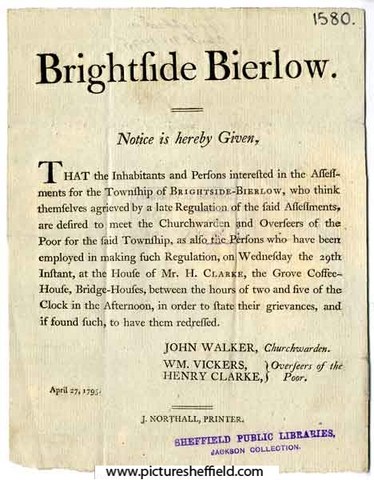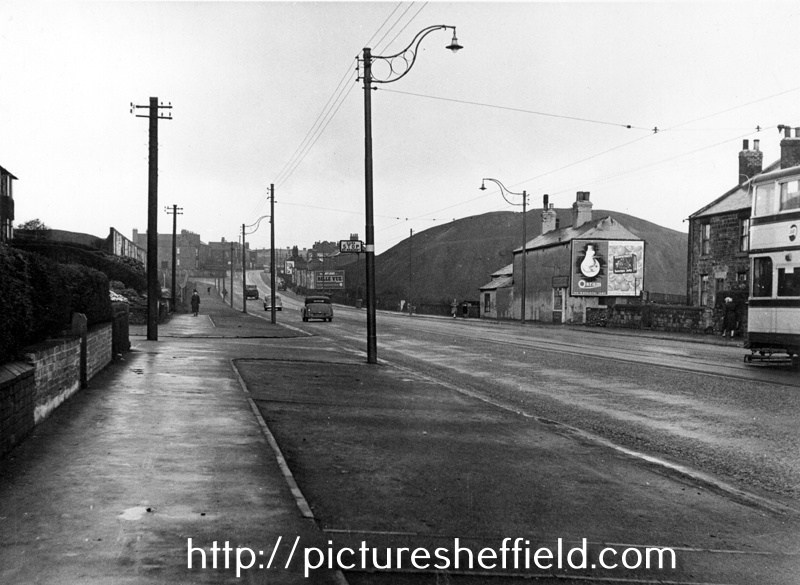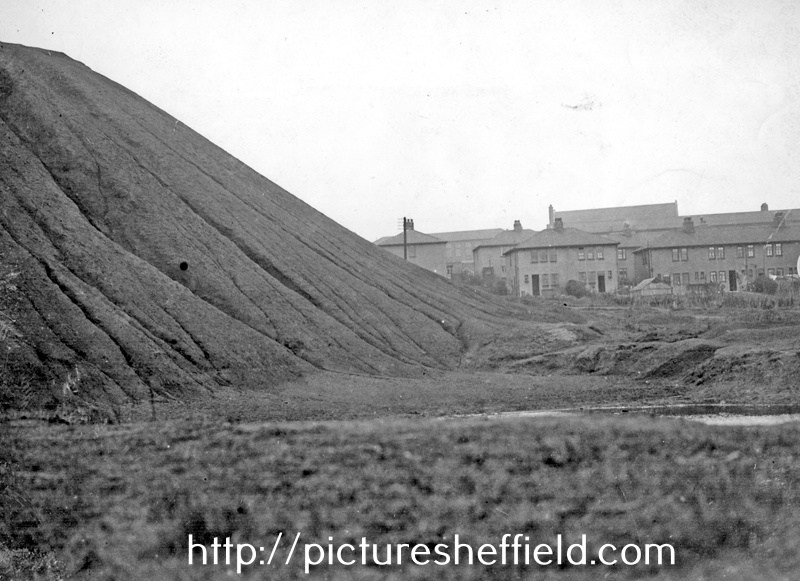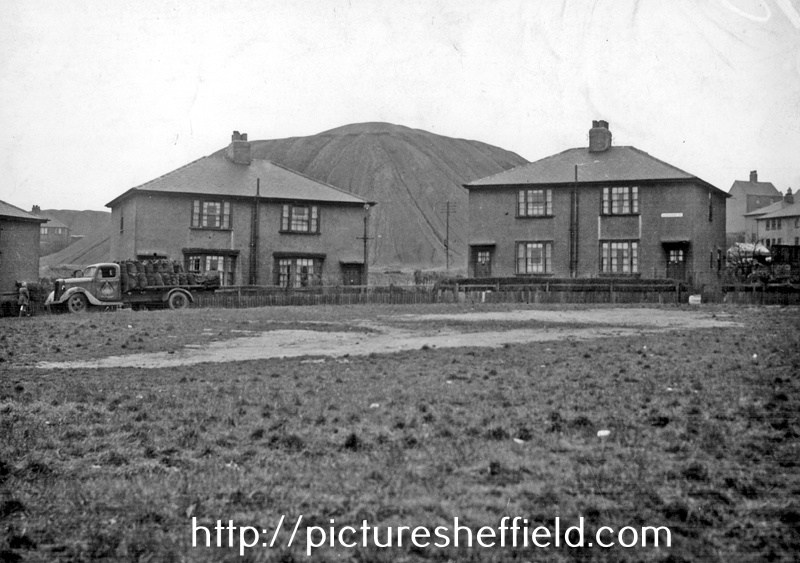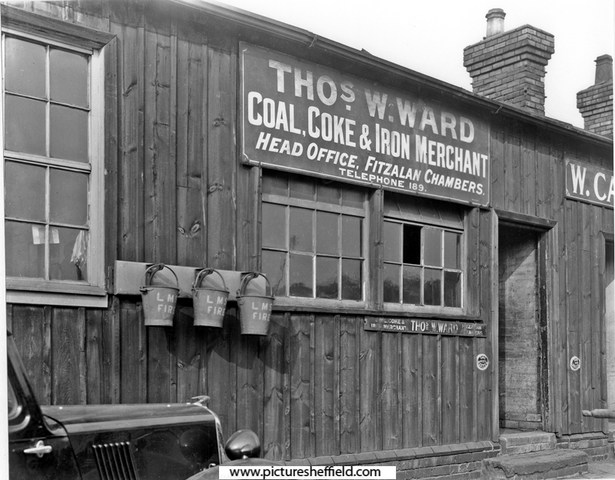Search the Community
Showing results for 'coal pit lane'.
-
Hi togger, Info from: Public Notice in Daily Independent 2nd January 1935 listing clearance schedules under the 1925 and 1930 Housing Acts various adverts in Sheffield Independent and Evening Telegraph from 1869 - 1903 Littlewood family, coal merchants, at 69 Edward street. William Lewis Littlewood operated a number of boats (at least 5) in the coal trade on the Canal, he died in 1900.
-
I'm trying to find out more about this site near Hillsborough corner, which is currently being looked after as a community garden. I haven't been able to find a photo of it from the past. Any info gratefully received by the group
-
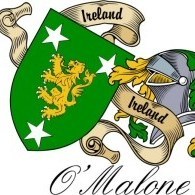
Moulson Brothers, Merchants and Manufacturers of Saws and Edge Tools etc., Union Works, Division Street
tozzin replied to Ponytail's topic in Made In Sheffield
Moulson Brothers Saw & Edge Tool manufacturers Union Works Green Lane The faded name of Moulson Brothers Saw & Edge Tool manufacturers on what was the Union Works entrance on Green Lane, its now part of a flats complex on another world famous manufacturers of Files & Saws Alfred Becket’s Brooklyn Works, when I spotted this gateway, I could see some faded writing but I could work out the manufacturers name, I could see it was Union Works and on further research I found it was part of the Moulson Brothers little tools empire. Moulson had been launched by the 1820s as a maker of saws and joiners' tools and by the 1830s was based in Union Works, Division St. Thomas and John Moulson appears to have been the brothers involved, though by 1850 other members of the family were active. Although they specialised in tools, the Moulson’s also traded in cutlery. Moulson Bros had an office in Pearl St, New York, by 1850. Moulson Bros best known partner was Thomas Moulson, who became Master Cutler in 1854. He was censured by the Company of Cutlers in his year of office for expressing the view after the Paris Exhibition that the Sheffield trade was backward and declining. Several Moulson partners died in the early 1860s. These included Thomas Moulson of Machon Bank, on 4 December 1862, aged 70. He was buried in Ecclesall. Joseph Moulson died 7 December 1866, aged 43. John Moulson of Stone Grove, died on 6 January 1864 aged 69, and was also buried in Ecclesall. The firm continued to trade on Division St under new Moulson managers, such as William Henry Moulson. A further company, John Moulson, was listed in 1868 as a merchant and manufacturer of table and spring knives, and edge tools, at Globe Works, Penistone Rd. It seems likely that the owner was a descendent of one of the Moulson Bros. John Moulson-like other cutlers at the Globe Works, Ibbotson Bros, Walter & Unwin & Rodgers had cultivated the American trade. He was described as an American Agent with a New York Office. Henry Elliott was John's agent in Sheffield and he also worked for Moulson Brothers. By 1875 that company was bankrupt, with debts of over £6.000 a situation that was not helped when in the following year Elliott embezzled £2.000 and absconded to America, he did return to face the music. In the 1880s, both John Moulson and Moulson Bros were listed at the same address in Division St and Green Lane. William Henry Moulson withdrew from Moulson Bros & Co in 1880, leaving the business to his partner Thomas Griffiths. However Moulson Bros had ceased trading by the end of that decade. William Henry Moulson, of Broomgrove Road, died 7 Feb 1890 aged 64 and was buried on the 1st of March in the Ecclesall church of All Saints. John Moulson appears to have retired in about 1885. The New York Times 8 Feb 1901, recorded his death on the previous day at Grosvenor Hotel and commented that he: “was well known in the cutlery trade in this city. He came from Sheffield, England, in 1849, as a salesman and became later the American agent for an English cutlery house. He retired from business about fifteen years ago, and had lived since that time at the Brevoort House and layer at the Grosvenor“. As tool collectors all over the world, Sheffield Tools are highly prized as these tools still perform their tasks like they did on their day of manufacture, In the case of Robert Sorby and Sons the factory was known as Kangaroo Works. The kangaroo itself was one of a number of registered trade marks used extensively until the 1980's. The presence of Robert Sorby in the Antipodes is further reflected by medals and diplomas of distinction awarded in both New Zealand and Australia as well as in London, Edinburgh and Calcutta. Robert Sorby left the Kangaroo Works in 1934, the building was demolished in 2008 with only the archway surviving. This has been lovingly restored and opened to the public in March 2010 as part of the Hawley Collection at Kelham Island Museum, Sheffield. Robert Sorby products are sold all over the world to hobbyist and professional woodworkers alike who seek tools of the highest quality. The product range is by no means as wide as in previous years but is far deeper with particular specialisation in three woodworking areas - wood turning, wood carving and cabinet making. The invention of crucible steel by Benjamin Huntsman in Sheffield in 1742 was a real boon to the edge tool manufacturers for this uniform, higher grade of steel - far superior to anything else available in the world at the time - gave them a march on their competitors worldwide. In 1833 there were 59 edge tool and 74 saw makers registered in Sheffield. By 1860 these figures had increased to 78 and 100 respectively only to decline by 1888 to 68 and 86. Of those edge tool makers registered back in 1833 only Robert Sorby survives to this day. Indeed, it may be that Robert Sorby is the oldest manufacturer of hand tools in Sheffield. Certainly it is one of the oldest surviving companies of all types in the city. Many of those businesses were little more than one- or two-man operations based on the cutlers' "Little Mesters" principle whereby many workers were self-employed and allowed to rent space in a workshop. My two Yorkshire Dumplings Mr Dawson & Mr Sorsby are quite chuffed at their sudden fame thanks to the Retro, they now hand out business cards emblazoned with a Cabbage! One further thing on the Union Works gateway, the name of Barton’s Stables can be just seen, this man had stables in the Castle House on Ladysbridge and was a Vet at the Dogs Home that was opened there. -
Number 69 was demolished under Clearance Order 74A, 1934. These houses appear on the 1851 Ordnance Survey map. There was an archway (through to the coal dealer's yard?) between nos. 65 and 69 that had a store above it. The Hogan family appear to be the final residents of no. 69 during 1935, their son John at St. Vincents RC School passed his Secondary School Scholarship exam in July.
-

Can anyone work out what this says please.
Aaron James Hartley replied to boginspro's topic in Sheffield History Chat
Mary Ann is my 4th great grandmother, weren’t we looking at Sellars before? I have all those census’s, all transcripted aswell. Plus a picture of Joseph broadhead. Also some census’s are split and the sons William and Thomas are on a second page in the 1841 address, which throws any searches all over.Joseph’s daughter Sarah Ann would go on to marry David sellars’s (the huntsman) son Francis Simmons Sellars also a saw maker. 1841 Solly St. Residence:1841 Solley Street, Sheffield, Sheffield, Yorkshire, England Joseph Broadhead Age:13 Father (implied):Mathew Broadhead circa 1797 - occupation saw grinder Mother (implied):Ann Broadhead Siblings (implied):Sarah Broadhead Mary Broadhead Hanah Broadhead William Broadhead saw Grindr Thomas Broadhead saw Grindr John Broadhead Matilda Broadhead 1851 11 Claphams Yard Birth:Circa 1827 Sheffield, Yorkshire, England Residence:1851 11 Claphams Yd, Pea Croft, Sheffield, Yorkshire - West Riding, England Joseph Broadhead Age:24 Marital status:Married Occupation:Saw Grinder Wife:Mary Ann Broadhead Children:Sarah Broadhead Mary Ann Broadhead 1861 Hallam Head, Upper Hallam, Yorkshire, Joseph Broadhead Age: 33 Marital status: Married Occupation: Saw Grinder Inhabited: 1 Wife: Mary Ann Broadhead Children: Sarah A Broadhead Mary A Broadhead Joseph Broadhead Matthew Broadhead Thomas Broadhead Elizabeth Broadhead The next census I have after this is Garton Manchester 1871 with all the family. Then back to Sheffield by 1881 at Lydgate lane. -

Sheffield Castle - Excavating the Castle ruins..
southside replied to Sheffield History's topic in Sheffield History Chat
Castle Hill: Britain from Above 1921. The construction of Exchange Place is under way. The Sheaf culverted over and on the location of the Alexander Theatre(demolished 1914) the yet to be built Alexander Hotel. Castle Folds Lane running down from Exchange Street to Chandlers Row, rear of the shambles. https://www.picturesheffield.com/frontend.php?action=printdetails&keywords=Ref_No_increment;EQUALS;y10037&prevUrl= -

Sheffield Castle - Excavating the Castle ruins..
Ponytail replied to Sheffield History's topic in Sheffield History Chat
This Map covers the area in question. Sheffield - Wain Gate, Castle Folds, Hay Market and Dixon Lane, c. 1790. https://www.picturesheffield.com/frontend.php?keywords=Ref_No_increment;EQUALS;arc04278&pos=27&action=zoom&id=105920 Also marked are River Sheaf, Hospital Bridge, River Don, Ladies Bridge and Chandlers Row. Marked: John Ashmore, John Wilkes, William Green, Joshua Wigfull, and Luke Gray. Plan of Castle Hill area showing position of buildings and streets, surveyed 1889. y00870 Taken from 'Sheffield Castle Excavations', by J.B. Himsworth, Local Studies Ref: 914.274 SQ. -

Sheffield Betting ring raids of 1876, various Sheffield pubs
Edmund replied to Aaron James Hartley's topic in Sheffield Pubs and WMC's
Presumably Henry ran Steel Peach and Tozer. He lived at Tapton Court on Shore Lane. -

Last steam passenger trains in Sheffield
History dude replied to a topic in Sheffield Buses, Trams and Trains
It doesn't mean it was the end of steam in the Sheffield area in 1966. For a B1, loco was used to provide steam heating preheating at Nunnery and Heeley Carriage sidings. It was based at Barrow Hill for a time. Plus, there could well have been industrial locos in the area. The National Coal Board did have the stuff to run them! It was sort of free, unlike diesel! -

Sergeant Loosemore VC
Ponytail replied to Lysanderix's topic in Sheffield War Years and The Sheffield Blitz
Memorial in Clifford School Hall to Sgt. Arnold Loosemore, VC. 2009 a00444 To the Glory of God and in honoured memory of Arnold D. Loosemore, VC. OD. CM. Sergeant 8th Duke of Wellington's (West Riding) Regiment. Educated at Clifford School in this parish. Awarded the Victoria Cross 'for most conspicuous bravery and initiative during the attack on a strongly held enemy position. He displayed throughout an utter disregard of danger. Langemarck [Belgium], 11th August 1917'. He died April 10th 1924 aged 27. For God and Country. Memorial to Johnson Family and Sergeant Arnold Loosemore, VC, Ecclesall Churchyard. March 2013. a00845 a00846 The Loosemore's - a patriotic Sharrow family. 1st June 1916. y07347 Seven brothers who are serving in the forces. They are the sons of Mr and Mrs G. H. Loosemore, 1 Lescar Lane, Sharrow Vale, Sheffield. Reading from left to right are:- Private Arnold Loosemore, Duke of Wellington's Regiment; Private George Arthur Loosemore and Private Harry Loosemore, both of the K.O.S.B.; Private J. J. Loosemore, A.S.C. of 35, Eastwood Road, Sheffield; Private John William Loosemore, Royal Engineers; Private Frank Loosemore, Royal Engineers; and Private Ernest Loosemore, of the York and Lancaster Regiment. They are all on active service. Image from Photographs from the Sheffield Daily Telegraph, 1914-1917 vol. 2 (Local Studies 940.43 SSTQ) -

Sergeant Loosemore VC
Richard Ineson replied to Lysanderix's topic in Sheffield War Years and The Sheffield Blitz
He lived on Dyson Place off Sharrowvale Road, he was provided with a smallholding at Castleton after the war and I think his son lived on Lescar Lane, also off Sharrowvale Road. -
Thanks Southside, an interesting link. Before fans were introduced the usual manner of inducing circulation was a furnace low down in the upcast pit. Hot air rises (the stack effect) drawing the exhausted air out of the colliery. Prior to 1862 it was common in the northeast to have single pit collieries. The shaft was divided in two by a brattice of wood and cloth. One side of the brattice acted as upcast, the other as downcast. however at Harley the only shaft became blocked by a broken pumping engine beam and the men below suffocated before they could be rescued. Hence the 1862 act I mentioned above.
-
Eadon's School's famous (in their day) pupils included Samuel Plimsoll, the sons of Thomas Firth (Mark, Edward, Charles Henry) and John Toothill (of John Toothill & Sons, St James' Row). Samuel Eadon was probably the son of John and Sarah Eadon - John was a schoolteacher, his school was in Red-Hill. Samuel Eadon M.A. graduated from Edinburgh University on 12th April 1834. In July 1836 Samuel Eadon M.A. F.S.A.S. (probably Fellow of the Society of Antiquaries Scotland) aged 25 married Ann Ash. The Whites Directory of 1837 shows Samuel running an academy in Beet street , his home was 7 St Georges Terrace. In July 1838 he moved the school from Beet street to a room belonging to the New Connexion Methodists in South street / Eldon street. Thus becoming the South Street School (Moor not Park) and in 1839 he added an "Initiatory Training Section" to the existing Junior and Senior Sections. Fees for the Young Gentlemen commencing their education would be one guinea per quarter (Junior fees were one and a half, and senior fees were two guineas) In 1840 Eadon was living at Pisgah Vale. In August 1848 his pupils presented him with a pair of fish slices. He did go off into some odd fields such as phrenology, homeopathy and hydropathy, taking on the role of a physician. In September 1850 the University of Erlangen (Bavaria) conferred on Mr Eadon the honorary degrees of Doctor of Philosophy and Master of Arts. He retired to live with his son also Dr Eadon, in Hambrook, near Bristol and died in December 1891 There is some information on this site, here: Mushroom Lane
-
And the new tier of local government is all part of Regional Devolvement of powers…with a touch of “ levelling up” I imagine. It’s all down to politics….so let me say that the new scheme is a million times nicer than the Fitzalan Square of the 1960s when I started being a townie in my drinking habits. The old, smelly downstairs loos attracted a certain a”clientele”…so a quick visit was called for before a dash to catch one of the late trams to Lane Top.
-

Methodist Churches in Sheffield
Ponytail replied to a topic in Sheffield Churches & Religious Buildings
Hatfield House Lane Methodist Church [former Primitive Methodist], from Winkley Terrace, c.1955. arc01197 Built 1883. First Chapel Wesleyan Methodist 1837, bought by Primitive Methodists in 1856. New School, 1948. Hatfield House Lane Primitive Methodist Church and School. c1906. https://www.picturesheffield.com/frontend.php?keywords=Ref_No_increment;EQUALS;v00716&pos=21&action=zoom&id=42524 Hatfield House Lane Methodist Church. 4th November 2004.c00397c00398 Hatfield House Lane Methodist Church from Winkley Terrace. 4th November 2004.c00395 Interior, Hatfield House Lane Methodist Church. c00400 -
An old chap who was still living on the Manor and an ex collier told me in the 1980s that he went down the Woodthorpe pit shaft and walked to the Nunnery end and came up that. Plus, the shaft that was present on the first map is now covered with slag.
-
Something isn't seem right in that summary. Ever since the Hartley Colliery disaster of 1862 and the subsequent "Act to Amend the Law Relating to Coal Mines of 1862", all collieries must have at least two shafts. The top pit may have stopped raising coal and men travelling in it, but it would have to be retained for ventilation and escape purposes until the whole colliery closed down.
-
There was a third pit just off the top of the map, which seems to have stopped quite early. The Incline track was a link to take coal from the lower pit to the Coke Ovens at the top. The top pit also stopped working before the lower pit. And you can see no trace of the track in the 1927 pictures. The tunnel under Mansfield Road was still visible from the Woodthorpe side in the 1970s and was bricked up. The other side was completely covered by the slag heap. The bridge abutments were still there, till the construction of the road to Applegarth. That destroyed three quarters of it, but left a small bit and the end stone with the caping. Which I think might be still there. The road filled in the rest. I assume the reservoir was to provide water for the steam engine to lift the pit cage. It was lined with cube shaped sandstone blocks, some of which went into the adjacent Boot house gardens for rockery purposes. Including that of 387, my house. I remember one had a fossil indentation of Cyclades on the front!
-
The more northern pit lies on the 525' contour, the southern lies between the 625' and 650' so clearly the southern pit is a bit over 100' higher. Look also at the reservoirs, one has an embankment around its northern end, the other has a straight dam.
-
The Story of Jack Timms, founder and builder of Pinegrove Country Club. University of Sheffield Alumni, 9th June 2022. https://www.sheffield.ac.uk/alumni/news/story-jack-timms Pinegrove Country Club, Myers Grove Lane, Stannington. 11th June 1981. https://www.picturesheffield.com/frontend.php?keywords=Ref_No_increment;EQUALS;s32165&pos=1&action=zoom&id=65384 https://www.picturesheffield.com/frontend.php?keywords=Ref_No_increment;EQUALS;s32166&pos=2&action=zoom&id=65385 Pinegrove Country Club 2008. https://www.geograph.org.uk/photo/971256
-
Penny Token of the Overseers of the Poor, 1812. s09460 Obverse shows West View of the Workhouse, Reverse shows Justice, standing with scales, on a pedestal. The Workhouse shown on these tokens was on West Bar. It was opened in 1733 enlarged in 1759, and demolished in 1829. Plan of a proposed Workhouse for Sheffield, between Broad Lane and Trippett Lane, c. 1791. https://www.picturesheffield.com/frontend.php?keywords=Ref_No_increment;EQUALS;arc01855&pos=21&action=zoom&id=71280 Shows work rooms, store room, dining room, laundry, brew house, kitchen, boiling house, bakehouse, oven, pantry, bread room, matrons room, store room, governors room, overseer room, doctors rooms, taylors room, poor attending on overseers [room], sick poor [rooms], bath, cells, etc. Original in Sheffield City Archives: WC/2075M. Notice of a Meeting at the Workhouse on Pitsmoor, in order to make an assessment for the relief of the Poor. 15th November 1794. arc01184 John Walker, Chapelwarden; William Vickers and Henry Clarke, Overseers of the Poor. Printed by Northall, Sheffield. Original at Sheffield Archives (JC/29/42). Notice of a Meeting called to consider the grievances of those people affected by a new Regulation of the Assessments for the Township of Brightside Bierlow. 27th April 1795.arc01185 John Walker, Churchwarden; William Vickers and Henry Clarke, Overseers of the Poor. Printed by Northall, Sheffield. Original at Sheffield Archives (JC/29/43).
-
The (old) Plumpers Hotel sited at the junction with Bawtry Road was rather a sharp turn and I remember as a child when travelling in the car with my parents, my mother always used to pipe up with a very nervous, "Careful Bob! it's a bad turning." which made me duck down in the back seat in fear of impending doom. In later years I don't think that turning was as nerve wracking as turning off Tinsley Roundabout when drivers realise they're in the wrong lane for Bawtry Road and others are gathering speed for the M1 slipway. Or coming from Bawtry Road drivers who think they can slip into the traffic on the island. After the demise of the steelworks in the area during the 1980's and being in rather an isolated position the Plumpers experienced a big fall off in trade and closed.
-
Steel workers Pub, bottom of Shepcote Lane.
-
Link to images restored: Mansfield Road looking towards the junction with Hurlfield Road with spoil tip on the right. 6th June 1955. u04511 Photographer: City Engineers and Surveyors Office. https://www.picturesheffield.com/frontend.php?keywords=Ref_No_increment;EQUALS;u04511&pos=1&action=zoom&id=40008 https://www.picturesheffield.com/frontend.php?keywords=Ref_No_increment;EQUALS;u04510&pos=1&action=zoom&id=40007 Also: Queen Mary Road, showing former Colliery tip at back of road (former Woodthorpe Colliery)s18968 Photographer: Press Photo Agency. Queen Mary Road, showing colliery tip (former Woodthorpe Colliery). s18969 Photographer: Press Photo Agency. Map of Richmond, Spring Wood and Woodthorpe, c. 1855. https://www.picturesheffield.com/frontend.php?keywords=Ref_No_increment;EQUALS;arc02931&pos=5&action=zoom&id=93426 From a volume of maps of the parish of Handsworth, based on the enclosure award maps (1805) and corrected up to 1855. Marked: Richmond; Richmond Road; Lamb Hill; Woodthorpe Common; Woodthorpe; Intake;Turnpike Road; Springwood Cottage; Woodthorpe Colliery; Coal Pit; Spring Wood; Parish Boundary. Woodthorpe Colliery 1854-1930. https://www.mindat.org/loc-383123.html Nunnery Woodthorpe Pit 1854-1928. https://www.mindat.org/loc-380201.html Sheffield Collieries (Sheffield, Handsworth, Woodthorpe, High Green, Chapeltown) Wm. Stobart. Section of the several beds of coal and ironstone. 1817. https://discovery.nationalarchives.gov.uk/details/r/c98cc644-645e-4203-9b6b-e3a7aea127c6
-
Were these premises part of Queens Road Coal Depot? T. W. Ward, Coal Offices, (Queens Road?) 23rd September 1936.s07237






























